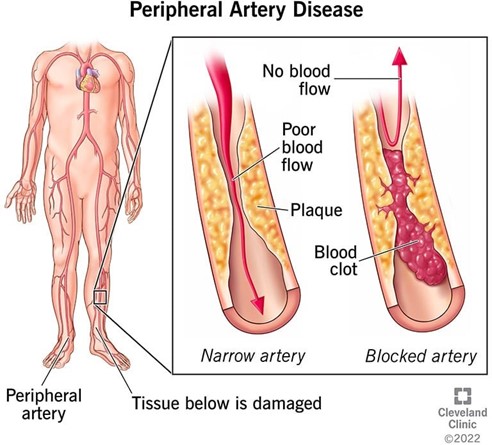A nurse is assessing a male client who has advanced peripheral artery disease (PAD). Which of the following findings should the nurse expect?
Thin, pliable toenails
Hairy legs
Leg pain at rest
Flushed, warm legs
The Correct Answer is C
feet or toes that occurs at night and is not relieved by rest.

Nursing Test Bank
Naxlex Comprehensive Predictor Exams
Related Questions
Correct Answer is D
Explanation
Moving objects away from the client is an important action to take during a seizure, as it can prevent injury and protect the client from harm.
"Place the client on his back." is not correct, as it can cause airway obstruction and aspiration. The client should be placed on his side, preferably in a lateral recumbent position, to allow saliva and secretions to drain from the mouth.
"Restrain the client." is not appropriate, as it can cause injury, increase agitation, or prolong the seizure. The client should be allowed to move freely during a seizure, but supported and guided away from hazards.
"Insert a padded tongue blade into the client's mouth." is not advisable, as it can cause oral trauma, choking, or damage to the teeth. The client should not have anything inserted into his mouth during a seizure, as he cannot swallow or bite his tongue. The nurse should ensure that the client's airway is clear and patent.
Correct Answer is C
Explanation
Ventricular gallop is another name for the S3 sound, which is a low-pitched sound heard at the end of diastole, just after the S2 sound. It is caused by the rapid filling of the ventricles and the vibration of the ventricular walls.
Closure of the pulmonic valve is one of the components of the S2 sound, which is a high-pitched sound heard at the end of the systole, just before the S1 sound. It is caused by the closure of the semilunar valves (pulmonic and aortic).
Closure of the mitral valve is one of the components of the S1 sound, which is a high-pitched sound heard at the beginning of systole, just after the S2 sound. It is caused by the closure of the atrioventricular valves (mitral and tricuspid).
d. Atrial gallop is another name for the S4 sound, which is a low-pitched sound heard at the end of diastole, just before the S1 sound. It is caused by atrial contraction and increased resistance to ventricular filling.
Whether you are a student looking to ace your exams or a practicing nurse seeking to enhance your expertise , our nursing education contents will empower you with the confidence and competence to make a difference in the lives of patients and become a respected leader in the healthcare field.
Visit Naxlex, invest in your future and unlock endless possibilities with our unparalleled nursing education contents today
Report Wrong Answer on the Current Question
Do you disagree with the answer? If yes, what is your expected answer? Explain.
Kindly be descriptive with the issue you are facing.
